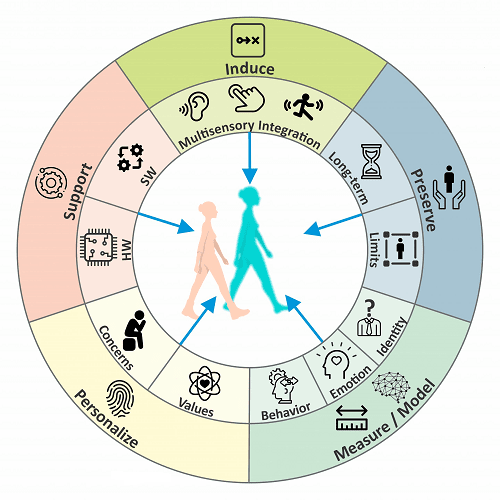The way we perceive our body influences how we behave, our emotions and how we socialize. But anyone who has been on a diet, or worked on a body-building program, knows that our bodies do not change very quickly. We may look in the mirror every two days, but what we see does not change overnight.
It is logical to assume that how we perceive our bodies – in our own minds – also stays the same. What we see in the mirror is what we see in our minds. In reality though the internal images we have in our minds are far from static. In fact they have been proven to be highly adaptable; distortions of body representations are a fascinating window into basic aspects of self-perception.
This adaptability has a particularly profound significance in mental health and medicine. Distorted body image representations are fundamental in several serious medical conditions, such as anorexia nervosa.
It is difficult to improve the matching between own-body perceptions that are externally perceived with realistic body representations (what really is in the mirror!). improving this would have clinical and practical implications in many areas.
Neuroscience research has achieved a success to a certain degree with virtual reality techniques, generating personalized realistic avatars using 3D scanning and computer-generated imagery techniques. But until now, the neuroscience of core sensory-driven changes in Mental Body Representations has been studied only in piecemeal experiments in very controlled settings that restrict body movement. This limits the experience and leaves no way to transfer basic principles of real-world complex environments – like movement – and experience a true realistic experience.
Researchers in the BODYinTRANSIT project are studying how Body Transformation Experiences (BTE), or perceptual illusions of body change, can be engineered, to create the illusion of being something different than what they are in reality. For example, illusions of being taller, shorter, wider, or slimmer.
Where computer technology meets behavioral science
The BODYinTRANSIT project utilizes sensor-based and bodily sensory feedback devices, used in immersive virtual reality, to create Body Transformation Experiences (BTE) to study and engineer perceptual illusions.
BODYinTRANSIT is a European Research Council-funded project hosted by the Universidad Carlos III de Madrid in Spain, and collaborates with researchers in University College London, Birkbeck-University of London, IRCAM in Paris, LMU in Munich, Tilburg University in the Netherlands, Ritsumeikan University in Japan and the Estonian Academy of Arts.
Distortions in both eating disorders and chronic pain have been shown to be exaggerations in a certain baseline pattern of distortions, suggesting that both these seemingly disparate conditions may relate to dysfunction in one mechanism for body perception. Evidence from neuro behavioral research indicates that distorted body image representations are also common in healthy individuals, occurring in tactile spatial perception, proprioception, and the conscious body image domains.
The BODYinTRANSIT is using systematic and iterative research to establish a theoretical ‘BTE design framework’ for individualized sensorial manipulation of mental body representations with long-lasting effects in everyday use scenarios that induce, measure, support, personalize and preserve body transformations. This involves embracing
- The neuroscience principles of multisensory body perception
- Data modelling of the links between body-representation, behaviour, emotion and social functioning
- Design and development of a wearable-based embodied multisensory interaction
- Field studies in real-life and on-the-move contexts with physically inactive users, somatic practitioners and users with body image concerns
This science, like all academic research, relies on reliable high-bandwidth compute resources to run advanced simulations. BODYinTRANSIT researchers benefit from the powerful GÉANT network backbone at their institutions to collaborate in real-time throughout Europe and via the NRENs at partner institutions in other countries and continents.
The tangible outcomes of the project are expected to include design principles, data formats, models, measures and paradigms to enable and guide BTE engineering innovations, like personalized BTE technologies that can measure mental body representations and adapt bodily sensory feedback to modify them.
By taking an interdisciplinary approach, and through collaboration on a global scale, this project is bringing technology out of the lab and into the real world. According to Dr. Ana Tajadura-Jiménez, the project coordinator, the long-term vision is to enable BTE technologies to measure body image and change it while the person is going about their daily life. “This could mean creating ‘smart clothing’ that improves a person’s body image, which could be a factor in increasing self-confidence, potentially enhancing emotional and physical health and social interactions.”
The possibilities are limited only by the imagination. In addition, to improving wellbeing and medical treatment, there is a lot of potential in the commercial sector, in the fields of robotics, virtual avatars, and apparel.
Image (c) Ana Tajadura-Jiménez














